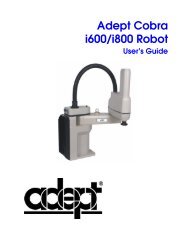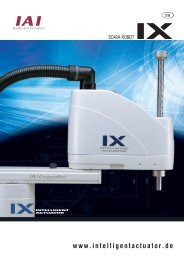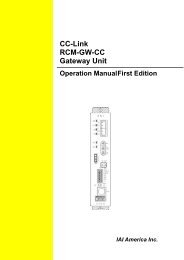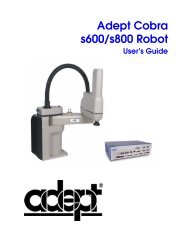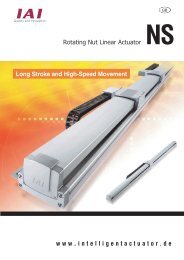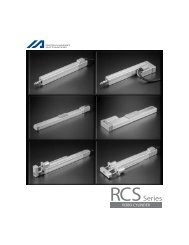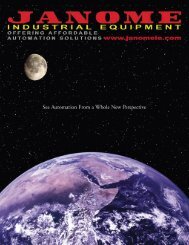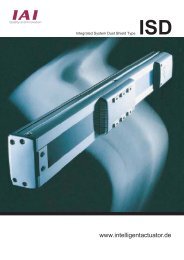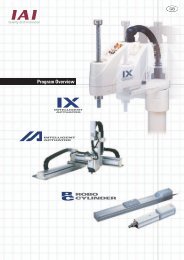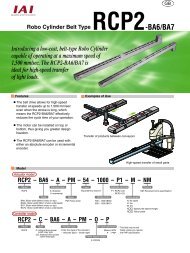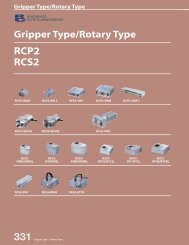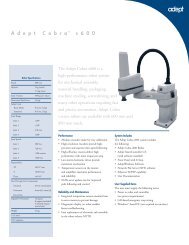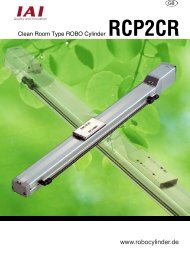Download Adept Cobra PLC600 User's Guide - pulsar.com.tr
Download Adept Cobra PLC600 User's Guide - pulsar.com.tr
Download Adept Cobra PLC600 User's Guide - pulsar.com.tr
You also want an ePaper? Increase the reach of your titles
YUMPU automatically turns print PDFs into web optimized ePapers that Google loves.
Robot Concepts<br />
Approach and Depart<br />
When approach and depart heights are specified, the robot moves in three distinct<br />
motions. In the first motion (approach), the robot moves to a location directly above the<br />
specified location. The height above the location is specified in N240:7 or<br />
<s<strong>tr</strong>ong>Adept</s<strong>tr</strong>ong>_Approach_Height (see page 81). For the second motion, N240:7 or<br />
<s<strong>tr</strong>ong>Adept</s<strong>tr</strong>ong>_Approach_Height is set to zero, and the robot moves to the actual location and the<br />
gripper is activated. In the third motion (depart), the robot moves to a point directly above<br />
the location. The depart motion uses the height specified by N240:7 or<br />
<s<strong>tr</strong>ong>Adept</s<strong>tr</strong>ong>_Approach_Height.<br />
Approach and depart heights are used to make sure that the robot approaches and<br />
departs from a location without running into any other parts in the assembly being built<br />
(or any other obs<strong>tr</strong>uctions in the robot envelope). Approaches and departs are always<br />
parallel to the Z-axis of the tool coordinate system. Notice that all the motion parameters<br />
that apply to a motion to a location also can be applied to approach and depart motions.<br />
This allows you to move at optimum speed to the approach height above a location, then<br />
move more slowly when actually acquiring or placing the part, and finally depart quickly.<br />
NOTE: Each of the three motions -- approach, move-to, depart -- must be<br />
<s<strong>tr</strong>ong>com</s<strong>tr</strong>ong>manded separately by the PLC<br />
Arm Configuration<br />
Another motion characteristic that you can con<strong>tr</strong>ol is the configuration of the robot arm<br />
when moving to a location. However, configuration options apply only to specific types of<br />
robots. For example, the lefty/righty option applies to SCARA-type robots (such as the<br />
<s<strong>tr</strong>ong>Adept</s<strong>tr</strong>ong> <s<strong>tr</strong>ong>Cobra</s<strong>tr</strong>ong> PLC), but the above/below option does not apply to those robots.<br />
Figure 10-1 shows how a SCARA robot can reach a point with the elbow pointing in two<br />
different directions. The Lefty/Righty arm configuration is specified in N240:3/13 or<br />
<s<strong>tr</strong>ong>Adept</s<strong>tr</strong>ong>_Motion_Qualifier.13.<br />
NOTE: Other arm configuration bits are supported by the PLC Server (see<br />
N240:3/13-15 or <s<strong>tr</strong>ong>Adept</s<strong>tr</strong>ong>_Motion_Qualifier.13-15). However, only the<br />
lefty/righty bit applies to a SCARA robot, such as the <s<strong>tr</strong>ong>Cobra</s<strong>tr</strong>ong> PLC robot.<br />
138 <s<strong>tr</strong>ong>Adept</s<strong>tr</strong>ong> <s<strong>tr</strong>ong>Cobra</s<strong>tr</strong>ong> <s<strong>tr</strong>ong>PLC600</s<strong>tr</strong>ong>/PLC800 Robot User’s <s<strong>tr</strong>ong>Guide</s<strong>tr</strong>ong>, Rev B



